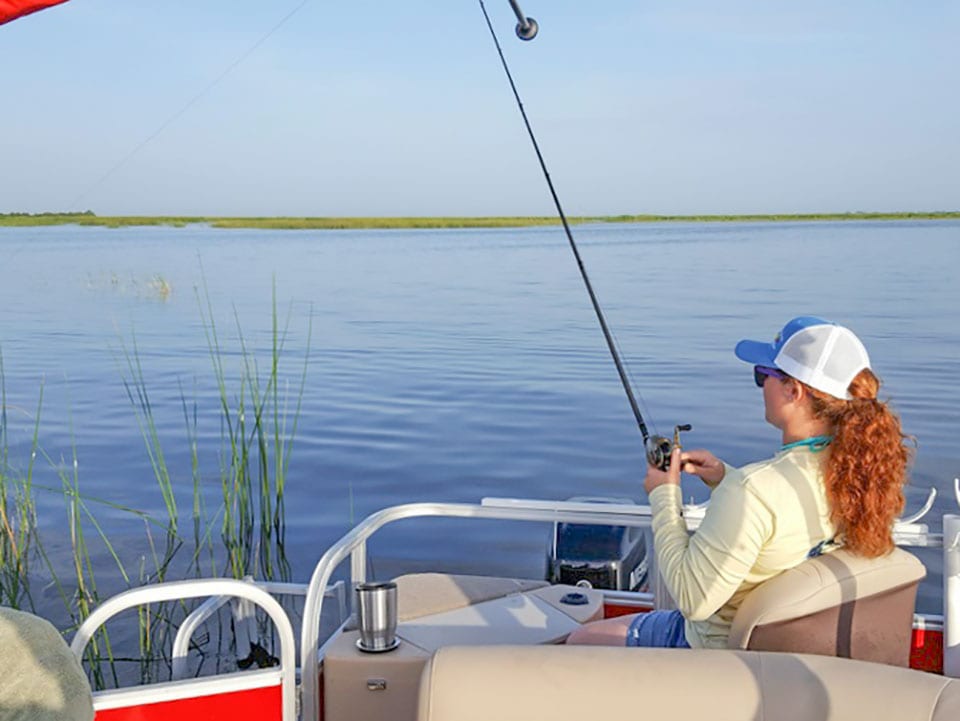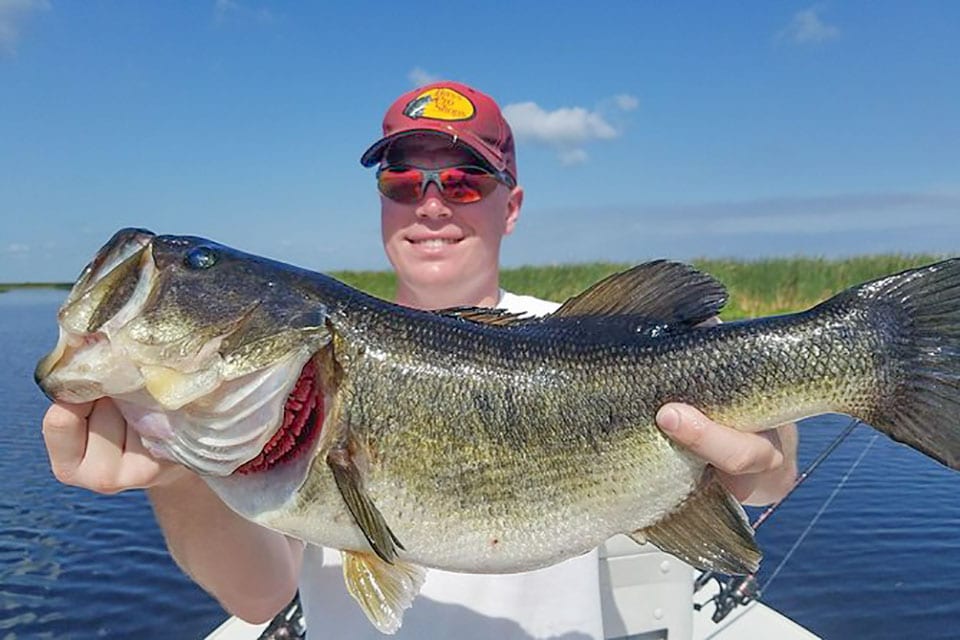Freshwater Fishing
Known at various times throughout history as Laguna del Espiritu Santo, and Mayaimi, Lake Okeechobee—from two Seminole Indian words meaning “big water”—is located in the center of Florida. It covers 730 square miles, has 135 miles of shoreline, and an average depth of nine feet. It is the second-largest freshwater lake in the continental United States after Lake Michigan. This amazing lake is known to be one of the best fisheries in the world and is host to a number of fishing tournaments for both professionals and the weekend angler.
Yes, There is Freshwater in Florida
Fed by rainfall and the Kissimmee River in the north, Lake Okeechobee is also referred to as Florida’s inland sea and plays an invaluable role in the local ecology.
The interconnected streams, rivers, and ponds that make up the Okeechobee basin are vital for Florida fish and wildlife. Its waters eventually end in the brackish estuary of the Everglades and provide flood drainage and water for the surrounding people and farms. They also create a beautiful natural habitat for fish, wading birds, and other freshwater species.
Lake Okeechobee is the Best Freshwater Fishing in Florida
When planning your central Florida vacation, out of all of Florida’s lakes, Lake Okeechobee provides the best fishing spot. This bass capital of the world is a must-stop for Florida freshwater fishing. With abundant amenities, including campgrounds, lodgings, marinas, and boat ramps, anglers can pick and choose their best Florida fishing vacation.
If you’re feeling adventurous and in search of travel ideas, you can boat down the Okeechobee Waterway. Built in 1937 as a response to storm flooding, the Okeechobee Waterway is a shallow man-made system of channels that stretch across southwest Florida from Fort Myers on the west to Stuart on the east coast.
You might want to make a quick jaunt to the coast for a bit of saltwater fishing. Stuart is just an hour north of West Palm Beach where you’ll find activities for the entire family.
What Kinds of Fish are in Lake Okeechobee?
Lake Okeechobee teems with native wildlife, from birds to wild hogs, manatees to turkeys, as well as the occasional alligator. The main draw, however, is the burgeoning numbers of game fish. Rich enough to support both commercial and game fishing, Lake Okeechobee boasts the best bass fishing in the world. You can also catch what the locals call “panfish,” or bream and black crappie (speck), as well as sunfish, catfish, pickerel, bowfin, and gar.
Anglers are encouraged to participate in the TrophyCatch and Big Catch programs. TrophyCatch is the Florida Fish and Wildlife Conservation Commission’s effort to collect data on trophy bass and encourage catch-and-release fishing. Don’t forget to register for a chance to win a new boat!
Big Catch is the state’s angler recognition program. With thirty-three different freshwater fish to choose from and categories for youth through advanced anglers, the entire family can participate. You must use an active hook-and-line method and send in a photo of your catch. The Big Catch website also houses the state’s records –both certified and uncertified.
The Largest Freshwater Fish in Florida Can Be Found in Lake Okeechobee
Best known for bass fishing, the “Big O” boasts some of the largest freshwater fish species in south Florida. Due to the lake’s shallow waters and the lack of natural predators, bass are at the top of the food chain. They can grow as large as 15 pounds (the uncertified record for largemouth bass currently stands at 15 pounds 5 ounces).
Several bass species are found here, including white bass, sunshine bass, spotted bass, black bass, butterfly peacock bass, shoal bass, and striped bass.
Everything You Need for Freshwater Fishing
Getting started is easy.
New to fishing or visiting Florida from out of state? There are several fishing charters you can hire for a day on the water with local experts. Typically, they provide everything you need.
However, if you’d rather head out on your own, here is a list of supplies you’ll need for what is, arguably, the best freshwater fishing in Florida:
• A fishing license
• A rod and reel
• Extra fishing line
• Hooks and lures
• Bait
• Bobbers
• Weights or sinkers
• Swivels
• Needle-nose pliers
• A line cutter
• A tacklebox
• A stringer, bucket, or cooler with ice
• Sunglasses, a hat, and sunscreen
• A first aid kit
Depending on the type of fishing you’re doing, this list will ensure your day at the lake is successful.
You Need a Freshwater Fishing License in Florida
As with other locations, the Florida Fish and Wildlife Conservation Commission requires a freshwater fishing license for all adults and youth ages 8 to 15 that are fishing. Depending on the number of fishing days you’re planning, the license can cost as little as $17 for three days for non-residents up to $79 for five years for Florida residents.
Further information regarding freshwater fishing licenses can be found here. (For Florida saltwater fishing licenses, navigate to this page.)
If you are planning on fishing in estuarine areas where fresh- and saltwater fish mingle, you may need both types of licenses. Make sure you know the freshwater fishing regulations and length limits before you head out!
Check them out on the Florida fishing and wildlife website here.
Licenses can be purchased online here from the conservation commission.
The Best Time to Go Fishing in Florida
With temperatures ranging from the mid-50s to the high-90s, there really isn’t a bad time to visit Lake Okeechobee.
If you’re looking for black bass, the most popular freshwater game fish in Florida, you’ll want to visit in March and April when the fish move into shallow waters to spawn. The redear sunfish also spawn during this time—look for them around the full moon.
Bluegill, however, reproduce throughout the summer, when they congregate in large beds in shallow water.
Black crappie, or “specks,” are deep water fish and are often caught in the cooler months. Do your school fishing offshore. You might also try in the early spring when they move to deep cover to spawn. Night fishing is especially productive during the summertime months.
Striped bass, white bass, and sunshine bass are stocked annually by the conservation commission. You’ll have the most success catching them in the fall through the spring months.
The butterfly peacock bass, a non-native species stocked by the wildlife commission, is only caught during daytime hours in open water. They are favored game fish and can reach up to nine pounds.
Best Freshwater Fishing Techniques
Your fishing technique will vary depending on the fish you intend to catch. Drifting slowly along the surface works best with deep, open water species. Remember to change the length of your line to trawl various depths.
You’ll find spawning fish in more shallow water, often near overhangs and dense vegetation. Flicking your lure over the plants and roots can attract hungry fish.
The Best Bait to Use for Freshwater Fishing
As with your technique, your bait will depend on the type of fish you’re hoping to catch. You can use everything from live worms, crayfish, and insects on your scented and colored lures when fishing the Big O. As a general rule, bait that moves, has a strong scent, and is appropriately colored to be seen (you’ll want both light and dark bait) will work.
If you’re planning to visit central Florida, the best bait in your tackle box is information. Check with your local expert, fishing guide, or a recent fishing report to get further insight.
Or, better yet, swap a few fish stories at the local bar and see what’s working for them.
Okeechobee offers a variety of guide services to ensure that you have the best possible fishing experience. For information on guides, click or contact:
Garrard’s Tackle Shop (863) 763-3416
Fast Break Inc. (863) 763-0973
Okeechobee Fishing Headquarters (863) 763-2248
South Florida Fishing & Hunting Outfitters (863) 697-3588
John’s Guide Service (863) 532-1720
Bass Fishing Guide Captain Ben Carroll (407) 922-7000
For more information please visit:
http://www.co.okeechobee.fl.us/departments/tourist-development

